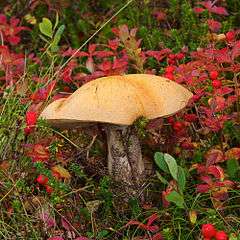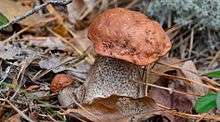Leccinum versipelle
Leccinum versipelle, also known as Boletus testaceoscaber or the orange birch bolete, is a common edible mushroom (given the right preparation) in the genus Leccinum. It is found below birches from July through to November, and turns black when cooked.
| Leccinum versipelle | |
|---|---|
 | |
| Scientific classification | |
| Kingdom: | |
| Division: | |
| Class: | |
| Order: | |
| Family: | |
| Genus: | |
| Species: | L. versipelle |
| Binomial name | |
| Leccinum versipelle | |
| Synonyms | |
| |
Description

The cap is broadly convex, bright red-brown or brick red. It is felty and grows up to 20 cm (8 in) in diameter. The flesh is white to pink, turning green-blue when cut, particularly in the stipe. The spores are brown. The stipe is firm, long and slender, white and covered with small black scales.
Edibility
Leccinum versipelle is mildly toxic (causing nausea and vomiting) unless given proper heat treatment: frying or boiling for 15–20 minutes is considered necessary. As mentioned, the mushroom turns black when heated.
It is commonly harvested for food in Finland.[1]
See also
References
- Ohenoja, Esteri; Koistinen, Riitta (1984). "Fruit body production of larger fungi in Finland. 2: Edible fungi in northern Finland 1976–1978". Annales Botanici Fennici. 21 (4): 357–66. JSTOR 23726151.
- E. Garnweidner. Mushrooms and Toadstools of Britain and Europe. Collins. 1994.
External links
Leccinum versipelle in Index Fungorum
Leccinum versipelle in MycoBank.